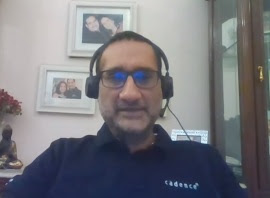Future trends in semiconductors and electronics

From Pradeep Chakraborty’s Techpoints blog
The National Program on Technology Enhanced Learning (NPTEL)-IIT Madras has launched a Special Lecture Series online for the benefit of students affected by the nation-wide lockdown to prevent the spread of Covid-19.
Jaswinder S. Ahuja, Corporate VP and India MD, Cadence Design Systems India Pvt Ltd, presented on the evolution of and future trends in semiconductors and electronics.
Jaswinder Ahuja
Cadence Design Systems is in the EDA and IP business for chips, packages and bolts. It has over 1,500 patents as a company. IP has nothing to do with patents. Moore’s Law is driving the industry. It has been driving the semiconductor and EDA roadmap for the last 50 years. The cost of implementing any functionality in silicon halves every two years. In reality, it is doubling in every 18 months. A multi-million dollar military flight simulators of the 1980s are sold for $250 today.
If we talk about the semiconductor processes, it used to be measured in microns. Now, it is measured in nm. The current leading edge is 7nm. The next will be 5nm, 3nm, 1.5nm, and then, nobody knows. Semiconductor scaling may end in some point of time. The economics are the key driver to advanced process technologies.
Trends driving semicon
Let us now look at the global trends driving semiconductors. The most profound trend is data. There is the IoT, data centers, servers, in-memory and Big Data, HDDs, DRAM and NAND, as well as the wireless and the wired infrastructures. There is data creation, processing, transmission and storage. There could be over 50 billion IoT devices by 2025. It can also be a trillion! For every living person on this planet, there will be at least seven to eight IoT devices generating streams of data. A lot of different applications and devices are coming up! Its creating momentum as well behind AI/ML. We are creating a virtual cycle of data.
Industrial, automotive and mobile will be driving edge computing. There is the Industry 4.0 as well. You have autonomous vehicles moving around, and a lot of technologies that you can experiment with. The large quantities of data being generated is also driving 5G and antennae. There are huge investments being made in the cloud and datacenters as well. A lot of decision making are also becoming very timing sensitive. Example, if a car gets a signal regarding an obstacle, you have to make a decision in milliseconds.
Some of the other key industry trends include, 5G, automotive, Industry 4.0 driven by ML, AI/OT, and cloud and data centers. These are driving the growth around electronics and semiconductors. With the advent of ML, and the need to process specific streams of data, there are a large number of startups coming up with normal architectures targeted to meet these challenges. Example, there are about 150 startups doing unique process architectures for different kinds of apps.
Moore’s Law is alive and well. It was earlier driven by lithography, novel architectures, device architectures, FinFETs, etc. In the future, it will be the co-optimization of the design and the underlying process technologies. Even further ahead, it will be co-optimization of system and the underlying technologies. There will be heterogeneous system integration.
More than Moore is also scaling over the last 5-10 years. If the digital portion of the chip can benefit from the scaling, and this can be done at 7nm or 5nm, and the analog chip is at 28nm, we can put some MEMS and sensors into a single package and create all kinds of new and interesting apps. Lab-on-chip is an example.
Focus on pervasive intelligence
Pervasive intelligence is a key driver for the industry. It is about autonomous vehicles and systems, intelligent edge and cloud compute, and intelligent networks and mobile devices. You can have autonomous cars, trucks, mining equipment, drones, robots, and personal assistants, etc. These can do predictive maintenance, embedded electronics, video surveillance, medical diagnostics coupled with AR, consumer data analytics, and provide business intelligence. These tasks can be performed over 5G self-organizing networks (SONs), smartphones, industrial Internet (4.0) and data center interconnect (DCI).
There are design elements in the intelligent systems. It involves data processing — Big Data, computer vision, and speech processing, decision and control — in planning, control and safety, and connectivity — in wireless, networking and security. All have ML as a common element. These are all driving the explosion of data and AI computational needs.
There are drivers of convergence in computational software. These are around system design such as algorithms, hardware, software and multi-physics, AI/ML such as data analytics and EDA, such as ICs, packages and PCBs. There is an explosion of data and AI computational needs, leading to exponentially growing cost and complexity of silicon design, and CPU and software performance scaling. We also need to address the thermal heating, so that the system does not break down. EMI is another area that needs to be addressed. Each one of the process nodes has an implication on the complexities and the cost of design.
Lot of opportunities
Cadence is leading the convergence of intelligent system design, with EDA, AI and system design. It is fueled by pervasive intelligence. There are a lot of opportunities for students as there are several global semiconductor companies in India. Several incubators and accelerators have also been set up. There is the Electropreneur Park, FabCi (Fabless Chip Design Incubator), SFAL, KLE Center for Technology Innovation and Entrepreneurship, and the Incubation Center at IIT Patna. In India, we have many unsolved problems. The challenge is to find the right problem to solve!
There are several projects going on. More needs to be done in areas such as clean, drinking water, energy conservation, renewable energy and smart energy, waste management, security, education, urban mobility and EV, EV charging and solar, healthcare and medical electronics. Eg., water ATM for clean, affordable water. There is also the Doorastha Analytics at the Electropreneur Park, New Delhi. It is working to optimize the efficiency of solar micro and mini grids. There are interesting problems that require interesting solutions. We need to solve real-world problems with innovative solutions.
Business leaders of tomorrow will be those who can solve the real-world problems in a scalable, profitable and sustainable manner. India is among the fastest-growing electronics market in the world. We have a huge opportunity. There is a huge potential in the bottom-of-the-pyramid solutions.












